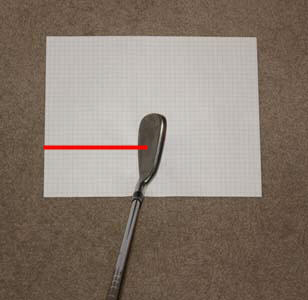Brian,
On re-reading the Fred Tuxen article, and thinking about it a great deal, your idea about aiming left/swinging left with an eight-iron seems increasingly sensible.
You stated that one needs to shift the plane line 2.24 degrees to the left to ensure that the clubface faces the target at impact to ensure a straight ball flight. How do you accurately aim left to such a small degree eg. 2 degrees?
What do you recommend for golfers who have less of a downward attack angle when hitting irons.
Here is video clip of Tom Watson hitting an iron.
YouTube - Tom Watson
He is simply clipping the ball off the turf without producing a divot. I presume that his clubshaft attack angle
at impact is close to zero. Should a golfer who clips the ball off the turf like Tom Watson aim straight? Where should he position his ball under those circumstances?
Consider this photo again.
I have simply placed the club on the ground in its neutral position - where the sole of the club is perfectly soled. If a golfer gets the club to impact using a zero clubshaft attack angle so that the clubface faces the target (exactly as demonstrated in that photo), will the ball not go straight?
Here is a photo showing Tiger Woods clubhead path when hitting a driver.
I get the impression that his clubhead is traveling almost parallel to the ground immediately pre-impact. Also, his clubshaft is near-vertical at impact implying that his ball position is at low point (or close to low point). Should Tiger Woods therefore aim straight to ensure a straight ball flight?
What about long-drive competitors who hit up at the ball. According to Fred Tuxen's article, a positive attack angle produces an out-to-in clubhead path. Should they therefore aim right if they want to hit the ball straight?
By the way, I was not advocating that a golfer hit the ball closer to the heel when I asked the question about the "effect of hitting the ball 1cm or 2cm closer to the heel". I simply want to
understand why hitting a ball closer to the heel affects ball flight
if the clubface is square to the target at impact, and I would like to know to
what degree it affects ball flight accuracy.
Jeff.


